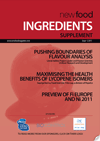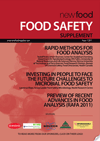Ingredients Supplement 2011
2 November 2011 | By Lionel Jublot, Supriya Varma
Pushing boundaries of flavour analysis (Lionel Jublot, Project Leader and Flavour Scientist, Unilever Research and Development) Maximising the health benefits of lycopene isomers (Supriya Varma, Food Scientist, Frito-Lay, a division of PepsiCo) Preview of FiEurope and Ni2011






